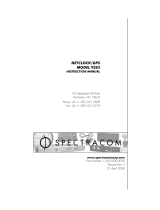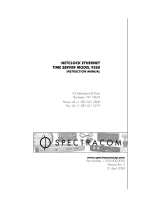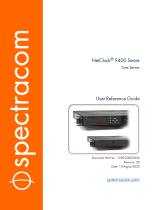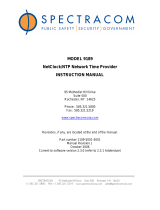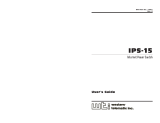Page is loading ...



SPECTRACOM LIMITED WARRANTY


1.1 Introduction ...................................................................................................................................................1-1
1.2 Inputs and Outputs: What Can the NetClock Do for You? ............................................................................1-1
1.2.1 Front Panel ............................................................................................................................................. 1-2
1.2.2 Front Panel LED Indicators ..................................................................................................................... 1-2
1.2.3 Front Panel LED Status Indications ........................................................................................................ 1-2
1.3 Rear Panel ....................................................................................................................................................1-4
1.4 Warranty Information and Customer Support ...............................................................................................1-5
1.5 Specifications ...............................................................................................................................................1-6
1.5.1 Receiver .................................................................................................................................................. 1-6
1.5.2 RS-232 Serial Setup Interface Port ......................................................................................................... 1-6
1.5.3 10/100 Ethernet Port ............................................................................................................................... 1-6
1.5.4 Protocols Supported ............................................................................................................................... 1-6
1.5.5 RS-232 Communication Port .................................................................................................................. 1-7
1.5.6 RS-485 Output ........................................................................................................................................ 1-7
1.5.7 Relay Outputs ......................................................................................................................................... 1-7
1.5.8 IRIG Output ............................................................................................................................................. 1-8
1.5.9 1PPS Output ........................................................................................................................................... 1-8
1.5.10 1PPS Input Specifications ....................................................................................................................... 1-9
1.5.11 Frequency Output ................................................................................................................................... 1-9
1.5.12 Input Power ............................................................................................................................................. 1-9
1.5.13 Mechanical and Environmental ............................................................................................................... 1-9
2.1 Inspection .....................................................................................................................................................2-1
2.1.1 Inventory ................................................................................................................................................. 2-1
2.2 Summary ......................................................................................................................................................2-2
2.3 Required Tools and Cables ..........................................................................................................................2-5
2.4 Power and Ground Connection ....................................................................................................................2-5
2.5 Rack Mounting ..............................................................................................................................................2-6
2.6 GPS Antenna Installation ..............................................................................................................................2-6
2.6.1 Antenna Cable for Outdoor Antenna ....................................................................................................... 2-6
2.6.2 Cable Lengths ......................................................................................................................................... 2-6
2.6.3 Model 8224 GPS Splitter......................................................................................................................... 2-8
2.6.4 Model 8226 Impulse Suppressor ............................................................................................................ 2-8
2.6.5 Model 8227 GPS Inline Amplifier ............................................................................................................ 2-9
2.7 Ethernet Network Cabling ........................................................................................................................... 2-11
2.8 Remote Port and Serial Comm Port Output Pin-outs and Wiring ............................................................... 2-12
2.8.1 Serial Comm Ports ................................................................................................................................ 2-12
2.8.2 RS-485 Remote Port ............................................................................................................................. 2-13
2.8.3 Remote Output Usage .......................................................................................................................... 2-14
2.8.4 RS-485 Guidelines and Cable Selection ............................................................................................... 2-14
2.8.5 Connection Method ............................................................................................................................... 2-15
2.8.6 Termination ........................................................................................................................................... 2-19
2.9 Ethernet Time Server (Model 9388) Installation ......................................................................................... 2-19
2.9.1 Connecting the RS-485 Input Port (Port 2) of the Model 9388 to a Spectracom NetClock’s Remote RS-
485 Output Port ........................................................................................................................................................ 2-21
2.9.2 Using One NetClock Remote Output Port ............................................................................................. 2-21
2.9.3 Using Two NetClock Remote Output Ports ........................................................................................... 2-23

2.9.4 Matching the Baud Rate and Data Formats (important information for installation) .............................. 2-24
3.1 Network Configuration with DHCP ................................................................................................................3-2
3.2 Initial Network Configuration .........................................................................................................................3-5
3.2.1 Using HyperTerminal to Connect to the NetClock................................................................................... 3-5
3.2.2 Initial Network Setup ............................................................................................................................... 3-9
3.2.3 Default and Recommended Configurations .......................................................................................... 3-12
3.3 Issuing the HALT Command before Removing Power ............................................................................... 3-13
3.3.1 Issuing the HALT Command through the Web UI ................................................................................. 3-13
3.3.2 Issuing the HALT Command through the CLI ....................................................................................... 3-15
3.3.3 Issuing the HALT Command through SNMP ........................................................................................ 3-16
3.4 Product Configuration Using the NetClock Web Interface .......................................................................... 3-20
3.4.1 Product Registration ............................................................................................................................. 3-20
3.4.2 Configuring NTP ................................................................................................................................... 3-20
3.4.3 NTP Support ......................................................................................................................................... 3-31
3.4.4 Configuring the Interface ....................................................................................................................... 3-32
3.4.5 Sysplex Timing ...................................................................................................................................... 3-47
3.4.6 Configuring the System: SNMP ............................................................................................................ 3-48
3.4.7 Configuring Alarms ............................................................................................................................... 3-51
3.4.8 Configuring GPS ................................................................................................................................... 3-52
3.4.9 Configuring System Time and Local Clocks ......................................................................................... 3-54
3.4.10 Setting the System Mode ...................................................................................................................... 3-61
3.4.11 Activating System Options and Rolling Back Updates .......................................................................... 3-63
3.4.12 Rebooting the System ........................................................................................................................... 3-64
3.4.13 Configuring System Holdover ............................................................................................................... 3-65
3.4.14 Configuring 1PPS Input ........................................................................................................................ 3-67
3.4.15 Serial Time Code Setup ........................................................................................................................ 3-68
3.4.16 Configuring System Logs ...................................................................................................................... 3-70
3.4.17 Configuring and Testing Relays ............................................................................................................ 3-72
3.4.18 Configuring Network Security ................................................................................................................ 3-81
3.4.19 If You Cannot Access a Secure NetClock ............................................................................................. 3-94
3.4.20 Configuring User Accounts ................................................................................................................... 3-95
3.4.21 Configuring SNMP v1, v2, and v3 ......................................................................................................... 3-97
3.4.22 Configuring LDAP and RADIUS .......................................................................................................... 3-101
3.4.23 Configuring IPSec ............................................................................................................................... 3-107
3.4.24 Logs and Status Reporting.................................................................................................................. 3-118
4.1.1 Event and Alarm Relay Outputs .............................................................................................................. 4-1
4.2 Leap Second occurrence ..............................................................................................................................4-2
4.2.1 Reasons for a Leap Second Correction .................................................................................................. 4-2
4.2.2 Leap Second Alert Notification ................................................................................................................ 4-3
4.2.3 Sequence of a Leap Second Correction Being Applied .......................................................................... 4-3
5.1 Format 0 .......................................................................................................................................................5-1
5.2 Format 1 .......................................................................................................................................................5-2
5.3 Format 2 .......................................................................................................................................................5-4
5.4 Format 3 .......................................................................................................................................................5-6
5.5 Format 4 .......................................................................................................................................................5-7
5.6 Format 7 .......................................................................................................................................................5-8
5.7 Format 8 ..................................................................................................................................................... 5-10
5.8 Format 90 ................................................................................................................................................... 5-11

7.1 Option 03: Modem ........................................................................................................................................7-1
7.1.1 Option 03 Basics ..................................................................................................................................... 7-1
7.1.2 Option 03-01 ........................................................................................................................................... 7-2
7.1.3 Modem Installation .................................................................................................................................. 7-2
7.1.4 Modem Configuration .............................................................................................................................. 7-3
7.1.5 ACTS Server Mode ................................................................................................................................. 7-6
7.1.6 Modem Dial-Out Setup ......................................................................................................................... 7-10
7.1.7 Modem Dialout ...................................................................................................................................... 7-11
7.1.8 Modem Testing ..................................................................................................................................... 7-15
7.1.9 Verify Modem Operation ....................................................................................................................... 7-17
7.2 Option 04: Rubidium Oscillator ................................................................................................................... 7-20
7.2.1 Comparison of the Rubidium oscillator to the OCXO and standard TCXO oscillators: ......................... 7-20
7.3 Option 05: OCXO Oscillator ........................................................................................................................ 7-21
7.3.1 Comparison of the OCXO to the Rubidium and Standard TCXO oscillators: ........................................ 7-21
7.4 Option 06: IRIG Input .................................................................................................................................. 7-22
7.4.1 IRIG Input Specifications....................................................................................................................... 7-22
7.4.2 IRIG Input Setup ................................................................................................................................... 7-23
7.5 Option 07: SAASM...................................................................................................................................... 7-25
7.6 Option 10: Low Phase Noise Rubidium 10 MHz and Differential IRIG Output ............................................ 7-25
7.6.1 10 MHz Output (FREQ OUT) Specifications ......................................................................................... 7-25
7.6.2 IRIG-B Output (Remote Port 2) Specifications ...................................................................................... 7-25
7.6.3 DC Input Power ..................................................................................................................................... 7-25
7.6.4 Rear Panel Connectors ......................................................................................................................... 7-25
7.7 Option 11: Modified IRIG Output ................................................................................................................ 7-26
7.7.1 IRIG-B Output Specifications ................................................................................................................ 7-26
7.7.2 IRIG-E Output Specifications ................................................................................................................ 7-26
7.7.3 ASCII Time Code Output (Format 09) ................................................................................................... 7-26
7.7.4 DC Input Power ..................................................................................................................................... 7-26
7.7.5 Serial Port 2 (Format 09) Configuration ................................................................................................ 7-27
7.7.6 Rear Panel Connectors ......................................................................................................................... 7-27
8.1.1 Troubleshooting front panel display indications ...................................................................................... 8-1
8.1.2 Not able to open the NTP Time Server’s web browser: .......................................................................... 8-2
8.1.3 Troubleshooting Web Interface Status page indications ......................................................................... 8-3
8.1.4 Troubleshooting conditions common to all Model 9300 NetClocks and Ethernet Time servers .............. 8-5
8.1.5 Troubleshooting NetClock NTP Time Servers (Models 9383 and 9389 only) ......................................... 8-9
8.1.6 Troubleshooting Ethernet Time Servers (Model 9388 only) .................................................................. 8-10
Figure 1-1: Front Panel Display ................................................................................................................................. 1-2
Figure 1-2: NetClock Rear Panel ............................................................................................................................... 1-4
Figure 2-1: Cabling without Inline Amplifier ................................................................................................................ 2-7
Figure 2-2: Cabling with Inline Amplifier ..................................................................................................................... 2-8
Figure 2-3: Model 8226 Impulse Suppressor ............................................................................................................. 2-9
Figure 2-4: Model 8227 Inline Amplifier ..................................................................................................................... 2-9
Figure 2-5: Serial Port Pin Configuration ................................................................................................................. 2-12
Figure 2-6: Remote Outputs ..................................................................................................................................... 2-13

Figure 2-7: RS-485 Output ....................................................................................................................................... 2-14
Figure 2-8: One-Way Bus Installation ...................................................................................................................... 2-15
Figure 2-9: Split Bus Configuration .......................................................................................................................... 2-16
Figure 2-10: Wire Strain Relief ................................................................................................................................. 2-17
Figure 2-11: TimeView RS-485 Interface ................................................................................................................. 2-17
Figure 2-12: Model 8179T TimeTap RS-485 Interface ............................................................................................. 2-18
Figure 2-13: Model 9288 RS-485 Interface .............................................................................................................. 2-18
Figure 2-14: TimeBurst RS-485 Interface ................................................................................................................ 2-19
Figure 2-15: Connecting a Single Model 9388 to a NetClock .................................................................................. 2-22
Figure 2-16: One-Way Bus Installation .................................................................................................................... 2-22
Figure 2-17: Split-Bus Configuration ........................................................................................................................ 2-22
Figure 2-18: Using Two NetClock Remote Ports to Obtain Two Different Data Formats ......................................... 2-23
Figure 2-19: RS-485 Input port ................................................................................................................................ 2-24
Figure 2-20: RS-485 Remote Output Port Configuration Screen ............................................................................. 2-26
Figure 2-21: RS-485 Input Port Configuration Screen ............................................................................................. 2-28
Figure 3-1: Entering to the Configuration in the Web UI ............................................................................................ 3-1
Figure 3-2: NetClock Web Browser User Interface .................................................................................................... 3-2
Figure 3-3: Security – Network Screen (1 of 2) .......................................................................................................... 3-3
Figure 3-4: Security – Network Screen (2 of 2) .......................................................................................................... 3-4
Figure 3-5: Establishing a New Terminal Connection ................................................................................................ 3-5
Figure 3-6: Connecting to the Computer’s Serial Port ................................................................................................ 3-6
Figure 3-7: Configuring the Serial Port Connection Properties .................................................................................. 3-6
Figure 3-8: Spectracom NetClock Command Line Interface (CLI) ............................................................................. 3-7
Figure 3-9: Available CLI Commands ........................................................................................................................ 3-7
Figure 3-10: Serial Port Pin Configuration ................................................................................................................. 3-8
Figure 3-11: Net Commands ...................................................................................................................................... 3-9
Figure 3-12: Prompt for Initial Configuration Values in the CLI .................................................................................. 3-9
Figure 3-13: Initial Configuration using the CLI ........................................................................................................ 3-10
Figure 3-14: Successful Completion of Network Configuration ................................................................................ 3-11
Figure 3-15: System Reboot/Halt Screen (1 of 3) .................................................................................................... 3-13
Figure 3-16: System Reboot/Halt Screen (2 of 3) .................................................................................................... 3-14
Figure 3-17: System Reboot/Halt Screen (3 of 3) .................................................................................................... 3-14
Figure 3-18: Command Line Interface (CLI) ............................................................................................................ 3-15
Figure 3-19: Halting the System from the CLI .......................................................................................................... 3-15
Figure 3-20: Rebooting the System from the CLI ..................................................................................................... 3-16
Figure 3-21: Reboot MIB Location Options (SNMP) ................................................................................................ 3-16
Figure 3-22: Rebooting the Unit through SNMP....................................................................................................... 3-17
Figure 3-23: Halting the Unit through SNMP ............................................................................................................ 3-18
Figure 3-24: Successful Halt .................................................................................................................................... 3-18
Figure 3-25: Web Interface Primary Menu ............................................................................................................... 3-20
Figure 3-26: Web Interface NTP Menu .................................................................................................................... 3-21
Figure 3-27: NTP General Screen ........................................................................................................................... 3-22
Figure 3-28: NTP References Screen (1 of 2).......................................................................................................... 3-25
Figure 3-29: NTP References Screen (2 of 2).......................................................................................................... 3-26
Figure 3-30: NTP Symmetrical Keys Screen............................................................................................................ 3-28
Figure 3-31: NTP Autokey Screen ........................................................................................................................... 3-29
Figure 3-32: Statistics FTP Screen .......................................................................................................................... 3-30
Figure 3-33: NTP Status Screen .............................................................................................................................. 3-31
Figure 3-34: Interface Menu ..................................................................................................................................... 3-32
Figure 3-35: Interface Serial Port 1 Screen .............................................................................................................. 3-33
Figure 3-36: Interface Remote Port 2 Screen .......................................................................................................... 3-34

Figure 3-37: Interface IRIG Screen .......................................................................................................................... 3-35
Figure 3-38: IRIG Output Level ................................................................................................................................ 3-37
Figure 3-39: IRIG B Time Code description ............................................................................................................. 3-38
Figure 3-40: IRIG E Time Code Description ............................................................................................................ 3-42
Figure 3-41: Interface Front Panel Display Screen .................................................................................................. 3-44
Figure 3-42: Interface Frequency Output Screen ..................................................................................................... 3-45
Figure 3-43: Interface Set to Defaults Screen .......................................................................................................... 3-46
Figure 3-44: Configuring Serial Port 1 for Sysplex Timing ....................................................................................... 3-47
Figure 3-45: System Menu ....................................................................................................................................... 3-48
Figure 3-46: System SNMP Screen ......................................................................................................................... 3-49
Figure 3-47: Spectracom’s MIB ................................................................................................................................ 3-50
Figure 3-48: System Alarm Screen .......................................................................................................................... 3-51
Figure 3-49: System GPS Screen ............................................................................................................................ 3-53
Figure 3-50: System Time Screen ........................................................................................................................... 3-54
Figure 3-51: Local System Clock Screen (1 of 3) ..................................................................................................... 3-55
Figure 3-52: Local System Clock Screen (2 of 3) ..................................................................................................... 3-56
Figure 3-53: Local System Clock Screen (3 of 3) ..................................................................................................... 3-57
Figure 3-54: System Mode Screen .......................................................................................................................... 3-61
Figure 3-55: Mobile Mode Dynamics Codes ............................................................................................................ 3-62
Figure 3-56: System Update Screen ........................................................................................................................ 3-63
Figure 3-57: System Reboot Screen ........................................................................................................................ 3-64
Figure 3-58: System Holdover Screen ..................................................................................................................... 3-66
Figure 3-59: System Status Screen (1PPS Input Indicated) .................................................................................... 3-68
Figure 3-60: Serial Time Code Setup Screen ......................................................................................................... 3-69
Figure 3-61: System Log Configuration Screen (1 of 2) ........................................................................................... 3-70
Figure 3-62: System Log Configuration Screen (2 of 2) ........................................................................................... 3-71
Figure 3-63: Relay Menu .......................................................................................................................................... 3-72
Figure 3-64: Relay Output Screen ........................................................................................................................... 3-73
Figure 3-65: Event Timer Relay Screen ................................................................................................................... 3-74
Figure 3-66: Edit/View Event Timers ........................................................................................................................ 3-75
Figure 3-67: Relay Current Event Scheduler Screen ............................................................................................... 3-77
Figure 3-68: Relay Reset ALL Event Timers Screen ............................................................................................... 3-78
Figure 3-69: Set Event Clock Screen ....................................................................................................................... 3-79
Figure 3-70: Test Relays Screen ............................................................................................................................. 3-80
Figure 3-71: Security Menu ...................................................................................................................................... 3-81
Figure 3-72: Security Network Screen (1 of 2) ......................................................................................................... 3-82
Figure 3-73: Security Network Screen (2 of 2) ......................................................................................................... 3-83
Figure 3-74: Security SSH Screen (1 of 2) ............................................................................................................... 3-84
Figure 3-75: Security SSH Screen (2 of 2) ............................................................................................................... 3-85
Figure 3-76: Security HTTPS Screen (1 of 2) .......................................................................................................... 3-91
Figure 3-77: Security HTTPS Screen (2 of 2) .......................................................................................................... 3-92
Figure 3-78: Security User Account Screen ............................................................................................................. 3-95
Figure 3-79: Security User Account Screen (Assigning Privileges) ......................................................................... 3-96
Figure 3-80: SNMP Security Screen (1 of 3) ............................................................................................................ 3-97
Figure 3-81: SNMP Security Screen (2 of 3) ............................................................................................................ 3-98
Figure 3-82: SNMP Security Screen (3 of 3) ............................................................................................................ 3-99
Figure 3-83: Security LDAP General Screen ......................................................................................................... 3-100
Figure 3-84: Security LDAP Client Configuration Screen (1 of 2) .......................................................................... 3-101
Figure 3-85: Security LDAP Client Configuration Screen (2 of 2) .......................................................................... 3-102
Figure 3-86: Security RADIUS General Screen ..................................................................................................... 3-104
Figure 3-87: Security RADIUS Client Configuration Screen .................................................................................. 3-105

Figure 3-88: IPSEC IKE SA Configuration Screen (1 of 2) .................................................................................... 3-108
Figure 3-89: IPSEC IKE SA Configuration Screen (2 of 2) .................................................................................... 3-109
Figure 3-90: IPSec General Screen ....................................................................................................................... 3-112
Figure 3-91: IPSec Manual SA Configuration (1 of 2) ............................................................................................ 3-114
Figure 3-92: IPSec Manual SA Configuration (2 of 2) ............................................................................................ 3-115
Figure 3-93: IPSec General Screen ....................................................................................................................... 3-116
Figure 3-94: Status and Log Menu ......................................................................................................................... 3-118
Figure 3-95: Alarm Log Screen .............................................................................................................................. 3-119
Figure 3-96: Authorization Log Screen .................................................................................................................. 3-120
Figure 3-97: Event Log Screen .............................................................................................................................. 3-121
Figure 3-98: GPS Qualification Log Screen ........................................................................................................... 3-122
Figure 3-99: Journal Log Screen ............................................................................................................................ 3-123
Figure 3-100: NTP Log Screen .............................................................................................................................. 3-124
Figure 3-101: IKE Log Screen ................................................................................................................................ 3-125
Figure 3-102: Operational Log Screen ................................................................................................................... 3-126
Figure 3-103: Oscillator Log Screen ...................................................................................................................... 3-127
Figure 3-104: System Log Screen ......................................................................................................................... 3-128
Figure 3-105: Update Log Screen .......................................................................................................................... 3-129
Figure 3-106: GPS Signal Status Screen ............................................................................................................... 3-130
Figure 3-107: NTP Status Screen .......................................................................................................................... 3-132
Figure 3-108: System Status Screen (1 of 2) ......................................................................................................... 3-133
Figure 3-109: System Status Screen (2 of 2) ......................................................................................................... 3-134
Figure 4-1: Event and Alarm Relay Contacts ............................................................................................................. 4-2
Figure 7-1: Modem Switches ..................................................................................................................................... 7-2
Figure 7-2: System Modem Configuration Screen, Console Mode ............................................................................ 7-4
Figure 7-3: System Modem Configuration Screen, Client Mode ................................................................................ 7-5
Figure 7-4: ACTS Server Mode Selected ................................................................................................................... 7-7
Figure 7-5: ACTS Server Greeting ............................................................................................................................. 7-8
Figure 7-6: ACTS Server Statistics ............................................................................................................................ 7-9
Figure 7-7: ACTS Server Log ................................................................................................................................... 7-10
Figure 7-8: System Modem Dial Out Screen (1 of 2) ............................................................................................... 7-12
Figure 7-9: System Modem Dial Out Screen (2 of 2) ............................................................................................... 7-13
Figure 7-10: System Modem Calibrate Screen ........................................................................................................ 7-14
Figure 7-11: Modem Test Screen ............................................................................................................................ 7-16
Figure 7-12: Modem Dialout Log Screen ................................................................................................................. 7-18
Figure 7-13: IRIG Input Screen ................................................................................................................................ 7-23
Figure 7-14: Serial Port Configuration ...................................................................................................................... 7-27
Figure 8-1: Verifying the NTP Service Status............................................................................................................. 8-7
Figure 8-2: RS-485 Output Port Configuration ......................................................................................................... 8-13
Figure 8-3: RS-485 Input Port Configuration ............................................................................................................ 8-14
Figure 8-4: Verifying the Data Format 0 year value is set correctly ......................................................................... 8-15



Spectracom Corporation is a leading manufacturer of precise time-keeping devices used to
synchronize critical operations. Our products provide accurate, reliable, Legally Traceable
Time™ across your networks. The Spectracom 9300 series NetClock™ is a direct response to
customer needs for affordable time synchronization equipment that includes a variety of
necessary and widely used security, authentication, and networking features.
Note:
If you are installing a Model 9388 Ethernet Time Server, please
refer to Section 2.9: Ethernet Time Server (Model 9388)
Installation for specific installation instructions.
The 9300 Series NetClock time server provides disciplined timing using Network Time Protocol
(NTP). The NetClock meets or exceeds the National Emergency Numbers Association (NENA)
master clock standard and is ideally suited for delivering world-wide, split-second timing to
mission critical systems. The 9300 series offers enhanced reliability features, including oven-
stabilized crystal oscillator (OCXO) and Rubidium oscillator backups to maintain the NetClock’s
time standard if the time reference is lost. An optional dial-out modem provides additional back-
up and can function as the primary reference if desired. The 9300 series chassis is shock-and
vibration-resistant.
The 9300 series’ enhanced security features, which can be enabled and disabled by the user,
include IPsec, Secure Shell (SSH), Secure Sockets Layer (SSL), Secure Copy Protocol (SCP),
Secure File Transfer Protocol (SFTP), and SNMP v1, v2, and v3 with host access restriction.
The NetClock supports IPv4, IPv6, and centralized user authentication (LDAP/Active Directory,
RADIUS). NTP capabilities include peering, Stratum 2, and Autokey.
The NetClock can be configured and its reports accessed through a Web User Interface (Web
UI). A Command Line Interface (CLI) is also provided for initial product configuration through the
serial setup port. Once configured, the NetClock can be accessed, under appropriate security
policies, anywhere within a network. The product features browser-based remote diagnostics
and control as well as Flash memory for remote software upgrades. A 10/100 Mbps Ethernet
LAN port provides support for Network Time Protocol (NTP) over a variety of platforms,
including Windows 2003, 2000, and XP, Cisco, UNIX, Linux, and more. Remote control and
monitoring can also be performed through SNMP and Telnet.
NOTE: All features described are not available on all NetClock variants.
Spectracom NetClocks provide multiple outputs for use in networked devices and other pieces
of technology. A 1 Pulse Per Second (1PPS) output acts as a precise metronome, counting off
seconds of UTC time. A 10 MHz frequency reference provides a precise, disciplined signal for
control systems and clocks (as the inverse of time is frequency). IRIG output, used in many

military and some public safety and data centers, provides a time code for time-stamping of
data, as do the NetClock’s serial time code outputs.
The NetClock’s outputs are driven by its inputs – specifically, IRIG, serial time code, and (most
significantly) Global Positioning System (GPS) technology. GPS-equipped NetClocks track up to
twelve satellites simultaneously and synchronize to the satellite’s atomic clocks. This enables
NetClock-equipped computer networks to synchronize all elements of network hardware and
software (including system logs) over LANs or WANs – anywhere on the planet.
1.2.1 Front Panel
The front panel of the NetClock (Figure 1-1) consists of two separate, illuminated status LEDs
and two LCD displays (depending on the model). The LCDs (when installed) are configurable
using the Web Browser User Interface (Web UI). Options include time, date, day of year,
software versions, network information, fonts, and date formats.
The status LEDs, “Sync” and “Power,” indicate whether the NetClock is synchronized and
whether power is applied to the unit. The Power LED will not light if power is not applied. It will
indicate green if power is applied. The Sync LED has multiple states (Table 1-1).
Figure 1-1: Front Panel Display
1.2.2 Front Panel LED Indicators
Power: Green, always on.
Sync: Tri-color LED indicates the time data accuracy and equipment fault.
LAN: Green: Good Link indicator.
Yellow: Network activity.
1.2.3 Front Panel LED Status Indications
At power up, a quick LED test is run. The unit displays a Red – Green – Orange sequence.
LABEL
COLOR
ACTIVITY
DESCRIPTION
POWER
Green
On
Off
Power is supplied to the NetClock.
Power is disconnected.
SYNC
Multiple
States
Off
No fault but not synchronized to GPS. Holdover spec has not been met.
Green On
Synchronized to GPS. Time is valid and within the Locked to GPS accuracy specs.
Blinking Green
Holdover mode. Not synchronized to GPS but time is still within Holdover accuracy specs.
Also indicates the unit is synchronized with the optional dial-out modem (Option 03).
Yellow On
No longer synchronized to GPS but no unit fault. Time accuracy may not be meeting
holdover specs.
Blinking
Yellow
Unit is in power-up initialization mode. The unit is in this mode for the brief period between
power on and when it is operationally ready to receive satellite data.
Flashing Red
GPS antenna fault. This flash may occur over any of the other color conditions at runtime.

Red On
Unit fault. Time may not be valid. Overrides all other indicators.
Blinking Red
If the unit fails Power On Self Test (POST) then the indicator will blink in a sequence
indicating the failure code (consult factory)
Blink is defined as ½ second on, ½ second off
Flash is defined as
1
/
20
second on,
19
/
20
second off
Table 1-1: Status Indicators, Front Panel

The rear panel (Figure 1-2) provides several different outputs that are available for interfacing
the NetClock to various systems, as well as a means of initially configuring the unit’s network
settings. The rear panel also has a power jack for the power input, a connection for the GPS
antenna, and relay contacts for alarm monitoring and event alerts.
Figure 1-2: NetClock Rear Panel
FREQ OUT is a BNC output providing a 10MHz sinewave output.
1PPS OUT is a BNC output providing a once-per-second squarewave output.
IRIG OUT is a BNC output providing an IRIG signal for synchronizing certain voice recorders.
1PPS IN is a BNC female input used to provide an external 1PPS reference.
Serial Comm 1 and Serial Comm 2 are “DB9 female” connectors that provide RS-232 data
output to devices that can accept an RS-232 input for synchronization.
The two RS-485 connectors (RS-485 PORT 1 and PORT 2) provide an RS-485 data output for
synchronizing devices that accept an RS-485 input, such as wall display clocks and add-on
Ethernet Time Servers.
The SERIAL SETUP INTERFACE provides network and output port configuration capability.
The ETHERNET connector provides an interface to the network for NTP synchronization and to
obtain access to the Web UI. It has two small indicator lamps, Good Link (green LED) and
Activity (orange LED). The Good Link light indicates a connection to the network is present. The
activity light will blink when network traffic is detected.
Ethernet
Yellow
On
Off
LAN Activity detected.
No LAN traffic detected.
Ethernet
Green
On
Off
LAN Link established 10 or 100 Mb/s.
No link established.
Blink is defined as ½ second on, ½ second off
Flash is defined as
1
/
20
second on,
19
/
20
second off
Table 1-2: Status Indicators, Rear Panel
TIMER/ALARM RELAYS 1, 2, and 3 are configurable for remote alerts and monitoring.
The GPS ANTENNA connection is an “N” type connector for the GPS input from the antenna.
The POWER connector is the input for the DC power.

The CHASSIS GROUND connector provides a means of grounding the unit.
Warranty information is found on the leading pages of this manual.
Spectracom constantly strives to improve its products. We greatly appreciate any and all
customer feedback.
Technical support is available by telephone at US +1.585.321.5800. Please direct any
comments or questions regarding application, operation, or service to Spectracom’s Customer
Service Department. Customer Service is available Monday through Friday from 8:00 a.m. to
5:00 p.m. EST, excluding holidays.
Product support is also available by e-mail. Questions regarding equipment, operation, and
applications may be e-mailed to Spectracom Sales Support at:
sales@spectracomcorp.com
For repairs and technical support, questions may be e-mailed to Spectracom Technicians at:
techsupport@spectracomcorp.com
Visit Spectracom’s website for product information, application notes, and upgrade notices as
they become available:
http://www.spectracomcorp.com/
Please contact Customer Service before returning any equipment Spectracom. Customer
Service must provide you with a Return Material Authorization Number (RMA#) prior to
shipment. When contacting Customer Service, please be prepared to provide your equipment
serial number(s) and a description of the failure symptoms or issues you would like resolved.
Freight to Spectracom is to be prepaid by the customer.
Once you have obtained the RMA number, ship your equipment to the following address:
Spectracom Corporation
Repair Department, RMA# xxxxx
1565 Jefferson Road STE 460
Rochester, NY 14623

NOTE: The specifications listed herein are based on “standard” operation, with the unit
synchronized to GPS and with the GPS receiver in position hold (or the equivalent for
non-GPS units).
1.5.1 Receiver
Received standard: L1 C/A Code transmitted at 1575.42 MHz.
Satellites tracked: Up to twelve simultaneously.
Acquisition time: Typically <4 minutes from a cold start.
Antenna requirements: Active antenna module, +5V, powered by the NetClock, 16 dB
gain minimum.
Antenna connector: Type N, female.
1.5.2 RS-232 Serial Setup Interface Port
Function: Accepts commands to locally configure the IP network parameters
for initial connectivity. Also used as the interface to the dial-out
modem (Option 03).
Connector: DB9 female, pin assignments conform to EIA/TIA-574 standard,
data communication equipment.
Character structure: ASCII, 9600 baud, 1 start, 8 data, 1 stop, no parity.
1.5.3 10/100 Ethernet Port
Function: 10/100 BaseT auto sensing LAN connection for NTP / SNTP and
remote monitoring, diagnostics, configuration and upgrade.
1.5.4 Protocols Supported
NTP: NTP v4.2.0. Provides MD5 and Autokey. Stratum 1 or higher.
(RFC 1305, 4330)
Loading: ~4,000 requests per second, typical.
Clients supported: The number of users supported depends on the class of network
and the subnet mask for the network.
A gateway greatly increases the number of users.
HTTP, HTTPS Servers: For browser-based configuration and monitoring using Internet
Explorer 5 or Netscape 6 per RFC 1945 and 2068.
FTP: For remote upload of system logs and RFC 959.
Logging: Syslog
SNMP: Supports v1, v2c, and v3
Telnet: For limited remote configuration per RFC 854.

Security Features: Up to 32-character password, Telnet Disable, FTP Disable,
Secure SNMP, SNMP Disable, HTTPS, HTTP Disable, SCP,
SSH, SFTP.
Authentication: LDAP v2 and v3, RADIUS, MD5 Passwords, NTP Autokey
Protocol.
Connector: RJ-45, Network IEEE 802.3.
1.5.5 RS-232 Communication Port
Signal: Selected time Data Format in RS-232 levels when interrogated by
the connected device. This port may also be configured to provide
a continuous once-per-second output.
Connector: DB9 female, pin assignments conform to EIA/TIA-574 standard,
data communication equipment (DCE). No flow control.
Character structure: ASCII, 1 start, 8 data, 1 stop, and no parity.
Accuracy: Data stream on time marker within ± 100 microseconds of UTC on
Sync in Data Formats 0, 1, 3 and 8. Data Formats 2, 4 and 7
within ±1 millisecond of UTC.
Configuration: Baud rate and output Data Formats are selected using the web
browser user interface. Bit rate selections are 1200, 2400, 4800
and 9600 baud. There are eight Data Format selections available.
1.5.6 RS-485 Output
Signal: Selected time Data Format in RS-485 levels, output once-per-
second.
Connector: Removable 3-position terminal block (supplied).
Character structure: ASCII, 1 start, 8 data, 1 stop, and no parity.
Accuracy: Data stream on time marker within ± 100 microseconds of UTC on
Sync in Data Formats 0, 1, 3 and 8. Data Formats 2, 4 and 7
within ±1 millisecond of UTC.
Configuration: Baud rate and output Data Formats are selected using the web
browser user interface. Bit rate selections are 1200, 2400, 4800,
and 9600 baud. There are eight Data Format selections available.
1.5.7 Relay Outputs
Three separate outputs provided for either Programmable Event Timer Output or Major/Minor
Alarm indication.
Relay contacts: NO, NC, and Common.
Contact rating: 30 VDC, 2 amps.
Connector: 10-position 3.81 mm terminal block (mate supplied).

Programmable Timer Output:
128 On/Off events available. Timer events that are hourly, daily or
weekly only count as a single event so many events can be
programmed.
Major/Minor Alarms: Relay contacts allow remote monitoring of operational status. A
power failure, CPU failure loss of time sync, etc cause the alarm
relay to de-energize. The alarm relay returns to normal operation
(energized) when the fault condition is corrected.
1.5.8 IRIG Output
Signal: Selectable IRIG B or IRIG E, amplitude modulated sine wave (AM)
or pulse-width-coded (TTL/DCLS).
AM Carrier: IRIG B-1000 Hz.
IRIG E-100 Hz or 1000 Hz.
AM Signal Level: Adjustable from 0 to 10 Vp-p mark amplitude into loads of 600
ohms. Factory set to 2.0 V p-p into 600 ohms. Output should be
terminated with 600 ohms.
Accuracy: IRIG-B, IRIG-E 1000 Hz AM: ±20 microseconds of UTC.
IRIG-E 100 Hz AM: 200 microseconds of UTC.
IRIG-B, IRIG-E TTL/DCLS: ±2 microseconds of UTC.
Connector: BNC female.
Configuration: IRIG Formats B or E in AM or TTL/DCLS levels. Time data is
configurable with Time Zone Offsets and DST rules. Signature
Control may also be placed on the output signal. This feature
removes the modulation code from the IRIG output whenever the
selected alarm condition is present. The output is restored when
the fault is corrected.
IRIG Code Format
Description of code
B000
IRIG B, TTL, BCD,CF and SBS
B120
IRIG B, AM, 1 kHz , BCD,CF and SBS
E000
IRIG E TTL, BCD,CF and SBS
E110
IRIG E AM, 100 Hz, BCD,CF and SBS
E120
IRIG E AM, 1 kHz, BCD,CF and SBS
1.5.9 1PPS Output
Signal: One pulse-per-second square wave derived from the GPS
receiver.
Signal Level: TTL compatible into high impedance loads, 1.5 V base-to-peak
into 50 ohms.
Pulse Width: 200 milliseconds.
Accuracy: Positive edge within ± 50 nanoseconds of UTC when locked to
GPS.
/
